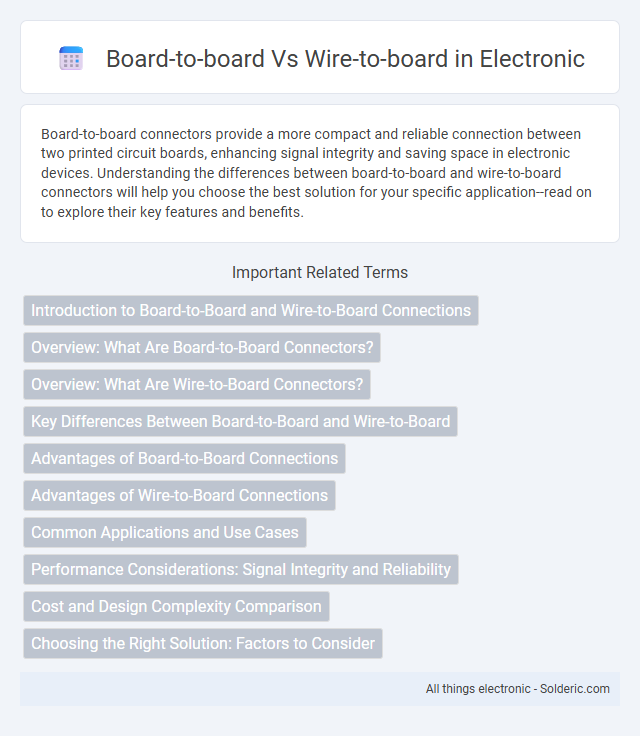Board-to-board connectors provide a more compact and reliable connection between two printed circuit boards, enhancing signal integrity and saving space in electronic devices. Understanding the differences between board-to-board and wire-to-board connectors will help you choose the best solution for your specific application--read on to explore their key features and benefits.
Comparison Table
| Feature | Board-to-Board | Wire-to-Board |
|---|---|---|
| Connection Type | Direct connection between two PCBs | Connection between wires and a PCB |
| Application | Stacked or adjacent PCB assemblies | External wiring or harness integration |
| Signal Integrity | Higher, due to short interconnects | Variable, depends on wire length and quality |
| Mechanical Stability | Strong and compact, with locking mechanisms | Less stable, relies on strain relief |
| Installation | Plug-in or press-fit connectors | Crimped, soldered, or IDC terminals |
| Cost | Moderate to high, due to precision connectors | Generally lower cost |
| Flexibility | Limited, fixed PCB spacing | High, customizable wire lengths and types |
| Common Uses | Internal PCB modules, memory cards, control boards | Power supply connections, sensors, external devices |
Introduction to Board-to-Board and Wire-to-Board Connections
Board-to-board and wire-to-board connections are essential interfaces in electronic device assembly, enabling communication between circuit boards and from wiring harnesses to boards, respectively. Board-to-board connectors provide compact, high-density connections ideal for multi-layer PCBs and modular systems, while wire-to-board connectors ensure reliable electrical paths from external wiring to a PCB. Industry applications prioritize selecting the appropriate type based on electrical requirements, mechanical stability, and space constraints to optimize performance and connectivity.
Overview: What Are Board-to-Board Connectors?
Board-to-board connectors enable direct electrical connections between two printed circuit boards (PCBs), facilitating signal, power, and data transfer while saving space and improving system reliability. Unlike wire-to-board connectors, which interface cables to PCBs, board-to-board connectors are designed for seamless stacking or side-by-side PCB arrangements, supporting high-density and high-speed applications. Your choice depends on factors such as mechanical strength, space constraints, and electrical performance required in your electronic device.
Overview: What Are Wire-to-Board Connectors?
Wire-to-board connectors are electrical components designed to link wires directly to printed circuit boards (PCBs), enabling efficient signal and power transmission in electronic assemblies. These connectors typically feature pins or sockets on the PCB side that mate with corresponding terminal contacts in the wire harness, supporting applications in automotive, consumer electronics, and industrial equipment. Compared to board-to-board connectors, which join two PCBs, wire-to-board connectors specialize in facilitating external wiring connections, optimizing space and flexibility in complex electronic systems.
Key Differences Between Board-to-Board and Wire-to-Board
Board-to-board connectors enable direct electrical connections between two printed circuit boards (PCBs), facilitating compact designs and high-density signal transmission. Wire-to-board connectors link cables directly to PCBs, offering flexibility in wiring and ease of maintenance through detachable connections. Key differences include their application scope, with board-to-board suited for internal PCB interfacing and wire-to-board ideal for external power or signal input/output connections.
Advantages of Board-to-Board Connections
Board-to-board connections enable compact, reliable interconnections with higher signal integrity and reduced electromagnetic interference compared to wire-to-board setups. They support high-density designs, allowing for efficient use of space in complex electronic assemblies while enhancing mechanical stability and durability. This connection type also simplifies manufacturing processes by minimizing assembly steps and improving automated alignment during PCB integration.
Advantages of Wire-to-Board Connections
Wire-to-board connections offer reliable electrical performance with straightforward assembly, reducing manufacturing complexity and costs. Their compact design ensures efficient use of space, ideal for high-density electronics requiring secure and stable connections. You benefit from enhanced flexibility in design customization, making wire-to-board solutions suitable for diverse applications.
Common Applications and Use Cases
Board-to-board connectors are commonly used in compact electronic devices such as laptops, smartphones, and medical equipment where multiple printed circuit boards need to be connected securely with minimal space. Wire-to-board connectors are preferred in automotive systems, industrial machinery, and consumer appliances where reliable connections between wiring harnesses and circuit boards are essential for power and signal transmission. Your choice between these connectors depends on whether you need direct PCB interfacing or flexible wiring integration in your application.
Performance Considerations: Signal Integrity and Reliability
Board-to-board connectors offer superior signal integrity by minimizing trace length and reducing electromagnetic interference, which enhances high-frequency performance compared to wire-to-board connectors. Wire-to-board connectors, while flexible for wiring configurations, introduce additional contact points and potential impedance discontinuities that can degrade signal quality in high-speed applications. Reliability in board-to-board systems is generally higher due to robust mechanical alignment and reduced vibration risk, whereas wire-to-board connections require careful strain relief to maintain consistent electrical contact over time.
Cost and Design Complexity Comparison
Board-to-board connectors generally offer lower overall system cost due to fewer interconnects and reduced assembly time, while wire-to-board connectors involve additional wiring and labor expenses increasing complexity. Design complexity is higher in wire-to-board systems as you must route and secure individual wires, whereas board-to-board solutions allow for more compact, reliable, and streamlined PCB layouts. Your choice impacts manufacturing efficiency and total cost of ownership, with board-to-board favored for dense, high-speed applications.
Choosing the Right Solution: Factors to Consider
Selecting between board-to-board and wire-to-board connectors depends on factors like space constraints, signal integrity, and ease of assembly. Board-to-board connectors offer compact, high-density connections ideal for tight spaces and high-speed data transmission, while wire-to-board connectors provide flexible wiring options suitable for modular designs and ease of maintenance. Assessing your device's mechanical layout, electrical requirements, and serviceability will guide you to the optimal solution for your application.
Board-to-board vs Wire-to-board Infographic

 solderic.com
solderic.com